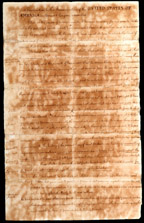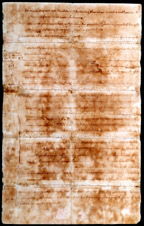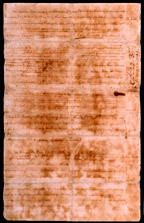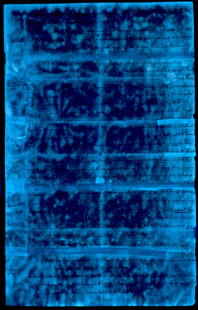 Page 1 (click for large version) |
 Page 2 |
 Page 3 |
 Page 4 |

Thomas Jefferson's Draft Declaration of Independence
 Page 1 (click for large version) |
 Page 2 |
 Page 3 |
 Page 4 |
Although the draft of the declaration was not placed at the APS until 1825, according to the Minutes of the Society and other archival records, by 1840, the Jefferson draft had already suffered considerably from frequent handling. On January 31 of that year, Librarian John Vaughan informed the donor, Richard Henry Lee, Jr., of the Society's intention to do something to prevent further damage.
. . . The Fair copy or as we call it, the original with your grandfather's remarks, we have had framed and placed between strong plates of glass turning on pivots so that it can be conveniently seen and examined without being touched . . .
 Ultraflourescent image of page 1, before treatment, showing glassine tape and other damage |
Thus, after careful examination, the conservators decided to remove the Jefferson draft from the glass and wooden enclosure in which it had been housed for over 150 years and treat the document to stabilize it and prevent further deterioration. The treatment included surface cleaning of the leaves with grated vinyl eraser and a soft brush. The glassine tape along the folds and margin was removed using poultices of methylcellulose and enzyme, and adhesive residues were reduced by swabbing around the text with cotton tips moistened with deionized water and ethanol. The tidelines were reduced using dilute ammonium hydroxide. The disassembled leaves were immersed in successive baths of ethanol and deionized water and the pH was adjusted to 7.5 with calcium hydroxide.
Small tears and losses were mended using acrylic and pastel-toned Tengujo (Japanese paper) adhered with cooked wheat starch. The reconstructed leaves are now housed in a state of the art sealed package to isolate them from atmospheric pollutants.